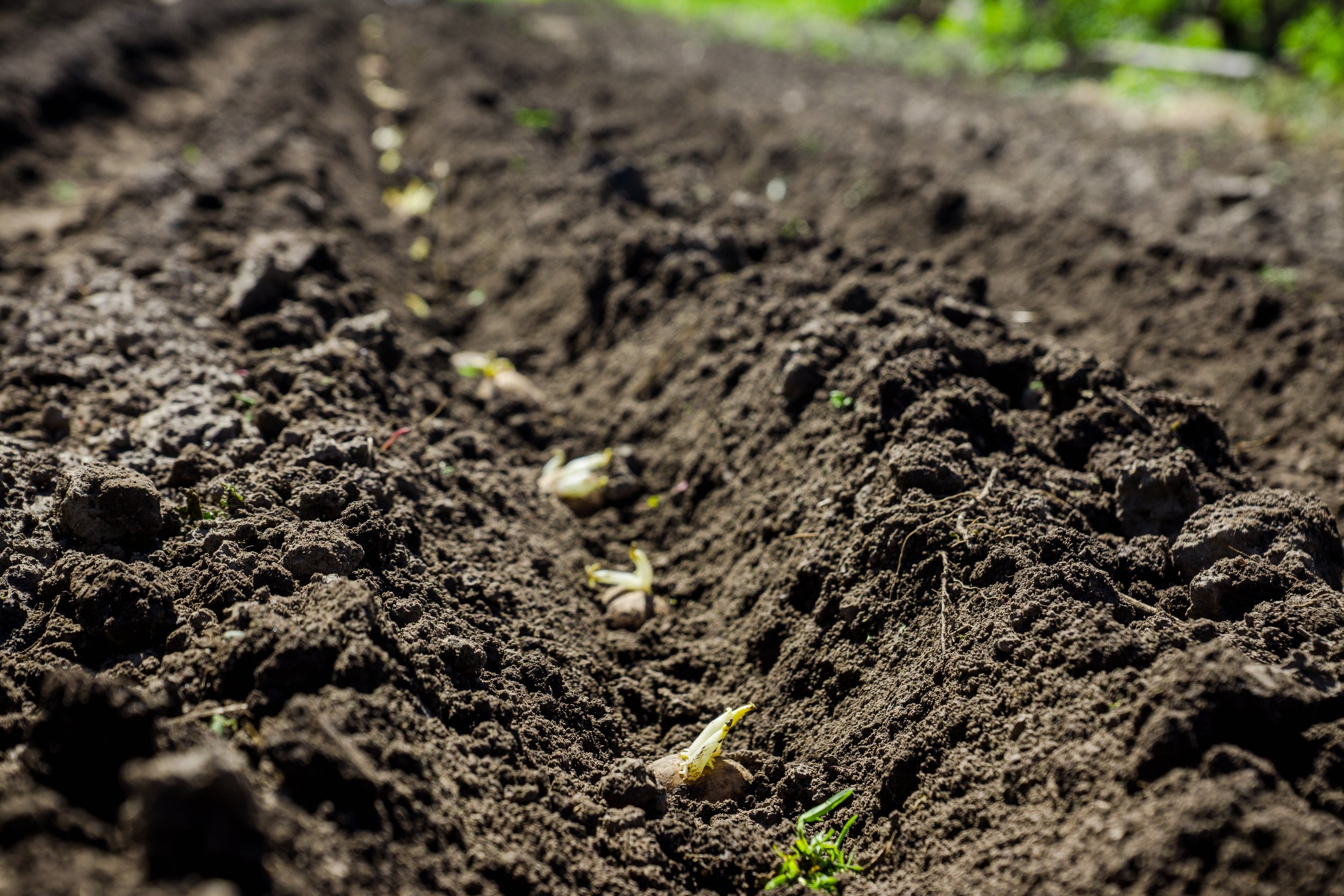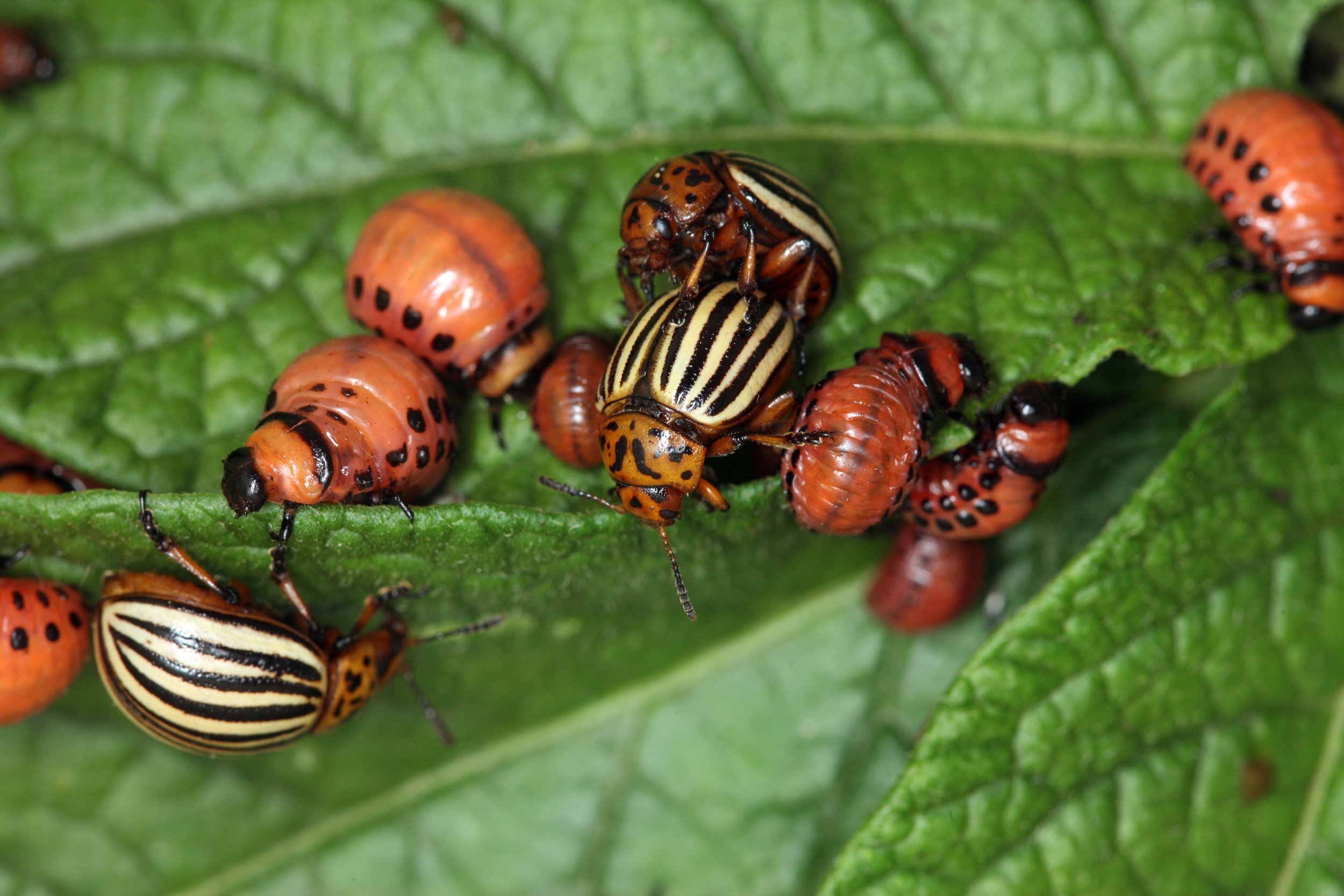Ask OGS: Growing Potatoes Organically
Dear OGS,
I have been thinking about planting potatoes, but I am not sure how to plant potatoes or when I can plant. What are the basics?
Oliver B.
Brevard, NC
———
Hi Oliver,
Some folks consider potatoes a fundamental and unexciting crop that doesn’t deserve placement in the high-dollar real estate of their garden beds. However, when you harvest your first potato crop, you will quickly realize that store-bought potatoes can never compete with the flavor-packed earthiness of a just-dug potato. Whether fresh-dug, new potatoes, or stored-for-winter potatoes, I have a great affection for this humble and versatile root crop!
Growing your own potatoes is smart, as they can appear on the Environmental Working Group’s (EWG) “Dirty Dozen” list depending on the farm or grower. If possible, make it a habit to check the group’s annual Shopper’s Guide to Pesticides, which ranks produce based on pesticide residue levels.
According to the EWG’s website, “The Dirty Dozen, or the 12 fresh non-organic, or conventional, fruits and vegetables with the highest pesticide residues, as well as the Clean Fifteen, the conventionally grown fruits and vegetables with very low or no traces of pesticides.” The group analyzes more than 45,000 non-organic produce samples from the U.S. Department of Agriculture and the Food and Drug Administration to compile the guide.
You can view the complete list on EWG’s website.
A Quick History of Potatoes
Potatoes have a rich history. They originated in the Andes Mountains of South America, where the Centro Internacional de la Papa in Peru has preserved over 4,000 edible potato varieties. By the mid-1500s, Spaniards began importing potatoes to parts of Europe, and just three centuries later, potatoes had become a large-scale mono-crop and an important food source for much of the Western world.
In the mid-1800s, late blight devastated the potato crop, causing massive crop failures. During the Great Famine in Ireland, over one million people died of starvation. Consequently, plant breeders utilized heirloom Peruvian potato stock to breed more blight resistance and genetic diversity back into potato stock.
Potatoes have gone global and are now the world’s fifth most important crop. They are found in most cultures, including China, whose population depends on potatoes. Most people associate a favorite potato dish with comfort food—French fries, mashed potatoes, potato soup, potato salad, potatoes au gratin, potato latkes, or plain baked potatoes.
The Basics of Growing Potatoes
Preparing Potato Seed for Planting
A potato “seed” is made by cutting whole potatoes into egg-size chunks that contain a couple of nice “eyes” (otherwise known as nodes or buds). Once you have cut up the potatoes, you can plant them right away. Alternatively, wait to plant and spread the potatoes out in a dry spot for a day or so, allowing them to scab over, or dust the potatoes with agricultural lime. This helps prevent rotting in the ground.
You will get 8-10 potato “seeds” per pound (twice as many for fingerling potatoes). Always start with certified seed potatoes to know your potatoes are disease-free. They can be found at your local garden center, seed stores, and farm supply stores. Buy ORGANIC certified seed potatoes if possible.
How to Plant Potatoes
The right conditions are key when it comes to planting potatoes. Start by selecting a spot with plenty of sunlight and well-drained soil rich in organic matter. Potatoes are heavy feeders, so nourish them throughout the growing season. You can do this by foliar feeding with liquid fish hydrolysate or seaweed (like Neptune’s Harvest) four to six times or by side-dressing with organic fertilizer as needed.
Prepare your seed potatoes and plant them about 3 to 4 inches deep and 12 inches apart. If you’re using fingerling potatoes, space them 15 to 18 inches apart in rows 3 to 4 feet apart. A simple method involves cutting a trench with a hoe, placing the potatoes in the trench with the eyes facing up, and then pulling the soil back over them. After covering, gently tamp the soil down using the flat side of the hoe. You can expect the plants to emerge in about two to three weeks.
“Hilling” Your Soil for Potato Growth
As your potato plants grow and reach about 8 to 12 inches tall, it’s time to “hill up” the soil. Use your hoe to pull soil from each side of the row and cover about two-thirds of the plant. This practice helps prevent the baby potatoes from greening, as exposure to sunlight can cause them to turn green and become bitter and even toxic. After the first hilling, you can hill up again when the plant grows another 6 inches, and optionally do it one more time later on.
Alternatively, consider applying a thick layer of wheat straw mulch around the potato plants. This helps retain moisture and keeps the soil softer where the potatoes are forming, which can ultimately lead to a greater yield. You can also plant potatoes in a container, adding soil or straw as the plant grows. Use high-quality soil for planting, and ensure the container is well-drained. Potatoes will rot in soggy soil.
When to Plant Potatoes
Most sources recommend planting potatoes about two weeks before the last frost. In the Southern Appalachians, that’s typically late April or early May. However, try to plant as early as possible—sometimes even in early March.
Early planting comes with a risk. If the weather turns cold and wet, the seed potatoes may rot in the ground, requiring a second planting. On the other hand, waiting too long increases the risk of losing the crop to late blight.
Karen Thatcher of Thatchmore Farm recalls her grandparents planting in March during the dark of the moon—the period after the full moon and before the new moon. Like Thatcher, I often follow lunar phases when planting and aim for the third quarter moon. Some folks also plant in late May when that is the only time available, regardless of moon signs.
Regional wisdom also suggests planting potatoes in early spring, often tied to the full moon or seasonal markers around the spring equinox. This typically falls sometime in March or early April for those watching the calendar.
Watering Potatoes
Potatoes require one inch of water per week. Drought conditions will compromise your yield, so remember to water when needed. Container-planted potatoes can dry out quickly, so be sweet to your plants and monitor moisture levels.
Harvesting & Storing Potatoes
Look for “new potatoes” when the plants begin to flower. You can dig up a whole plant or gently feel around the roots and harvest a few young potatoes for supper without disturbing the rest of the plant. Be sure to re-cover the roots with soil so the remaining potatoes don’t turn green from sunlight exposure.
As fall approaches—about two weeks after the plants start to yellow, brown, and die back—it’s time to dig your main crop. Wait until the soil isn’t too wet, and avoid watering the potatoes for about a week before harvest to help toughen their skins.
Use a potato or sturdy garden fork for harvesting—not a pitchfork. Start about a foot out from the center of the plant, push the fork deeply into the soil, and press back to loosen the roots. Carefully work in a circle around the plant to avoid damaging the potatoes. Gloves can help as you sift through the soil to find every last one.
Let the potatoes dry for a few hours in a shady spot before curing them. Protect them from sunlight, which can cause greening. Sort through the harvest and remove any signs of damage or spoilage. Eat any cut or bruised potatoes right away.
You don’t need to wash the potatoes before storage, but you may want to brush off large clumps of soil. Cure them for about a week and a half in a warm, humid, and dark place. This helps toughen the skin and heal minor bruises. Once cured, store them in a cool—but—not—freezing dark space. Breathable containers like sturdy cardboard boxes or brown paper grocery bags work well.
Potato Pests & Diseases
Be sure to rotate crops each season and avoid planting potatoes where other nightshades—such as tomatoes, peppers, or eggplants—have grown in recent years. Companion planting can also support healthy growth. Herbs and flowers like coriander, dill, sweet alyssum, fennel, and cosmos are often recommended around potato beds to attract beneficial insects.
Other Problems That Can Occur in the Region
Colorado Potato Beetle
This beetle is the most common potato pest in Western North Carolina, but is relatively easy to control by hand. Check plants regularly and remove eggs, larvae, and adult beetles by hand or by dropping them into a jar of soapy water. Lightweight floating row covers or a thick layer of mulch can also help suppress beetle populations.
Late blight
While many gardeners are familiar with late blight on tomatoes, it can also affect potatoes. Remove all volunteer potato plants in the spring and discard them as a preventative measure. Space plants adequately to allow for good air circulation between plants and rows, and water only at the base of plants to keep leaves dry. Products like Serenade and copper-based fungicides may help prevent the spread of late blight.
Scab
Scab is typically a cosmetic issue for home growers and does not usually affect yields. To avoid it, choose scab-resistant varieties such as Yukon Gold, Red Norland, Carola, and Chieftain.
Wireworms
Wireworms are most common in soil that was previously sod or recently turned. Keep an eye out when planting potatoes in a new or recently converted garden bed.
Potato Varieties
Potatoes come in many colors, shapes, and textures, with skin and flesh ranging from purple, red, and yellow to brown and white. If you’re not sure which variety to plant, try sampling the diverse cultivars available at local tailgate markets. Below are a few suggestions for varieties.
Kennebec (late)
This is a great all-purpose potato with brown skin and white flesh. It is a standard variety in the Western North Carolina mountains and a longtime favorite among seasoned growers. It also stores well.
Yukon Gold (early to midseason)
Brown skin with yellow flesh. Naturally buttery and flavorful. A reliable favorite that also stores well.
Red Pontiac / Red Norland (early)
Red skin and white flesh. These varieties are excellent for “new” potatoes, especially for boiling or in salads. They don’t store well long-term, but they’re delicious fresh.
All Blue (early to midseason)
Blue or purple skin and flesh. Striking in potato salads or soups — especially with the skin left on.
French Fingerling (mid to late)
Rosy skin with yellow flesh. Known for its gourmet quality. These potatoes are great in salads or winter soups and store well. Fingerlings are a fan favorite.
Homegrown potatoes are satisfying and flavorful, and there's still time to plant them this season.
Happy gardening!
This blog post, written and copyrighted by Ruth Gonzalez, was originally published as part of a previous Organic Growers School article series called "Ask Ruth," which addressed the gardening concerns of home growers. Some updates may have been made by OGS staff to keep the content current.





